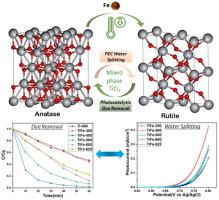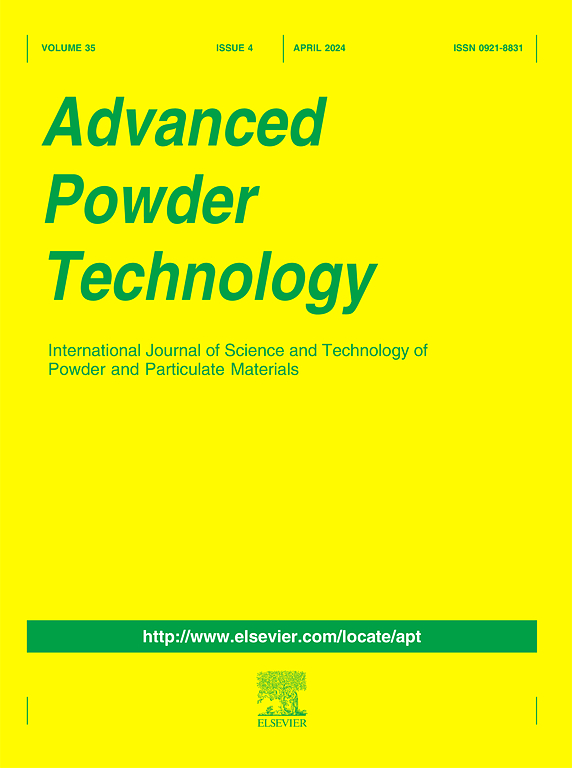通过实验和理论验证铁对改善掺杂混合相二氧化钛光催化性能的双重作用
IF 4.2
2区 工程技术
Q2 ENGINEERING, CHEMICAL
引用次数: 0
摘要
本研究提出了一种利用铁掺杂在低起始温度下形成混合相 TiO2 直接 Z 型催化剂的战略方法。从实验和理论角度解释了掺杂引起的改性。在最佳煅烧温度(TiFe-400)下,掺杂铁的 Z 型混合相 TiO2 表现出最大的光子吸收率,并减少了电荷载流子的重组,从而提高了光催化和 PEC 性能。TiFe-400 具有最高的甲基溴降解速率常数(在太阳光照射下为 0.084 min-1),并显示出优异的光氧化电流(0.8 mA,1.3 V 对 Ag/AgCl)。Z 型结构的形成极大地抑制了光载流子的重组,导致电荷载流子向高氧化还原电位的混合相 TiO2 定向迁移。这种迁移通过识别参与光催化过程的主要反应物得到了验证。这项工作同时展示了实验和理论方法,可为设计稳定、廉价的催化剂以实现工业规模的双重应用提供有价值的见解。本文章由计算机程序翻译,如有差异,请以英文原文为准。

An experimental and theoretical validation of dual role of Fe on improving the photocatalytic performance of doped mixed phase titania
The present work proposes a strategic approach of using Fe doping to form a mixed-phase TiO2 direct Z-scheme catalyst at low onset temperature. The doping-induced modifications are explained from the experimental and theoretical viewpoint. Fe-doped Z-scheme-based mixed-phase TiO2 at optimal calcination temperature (TiFe-400) exhibits maximum photon absorption and reduces charge carrier recombination, enhancing photocatalytic and PEC performance. TiFe-400 has the highest rate constant for the degradation of MB (0.084 min−1 under solar irradiation) and showed exceptional photooxidation current (0.8 mA, 1.3 V vs Ag/AgCl). The Z-scheme formation significantly inhibits the recombination of photocarriers, resulting in a directed migration of charge carriers to the high redox potential mixed-phase TiO2. This migration is validated by identifying the primary reactive species participating in the photocatalytic process. This work, demonstrating both experimental and theoretical approaches, may provide valuable insight into designing stable and inexpensive catalysts for dual applications on an industrial scale.
求助全文
通过发布文献求助,成功后即可免费获取论文全文。
去求助
来源期刊

Advanced Powder Technology
工程技术-工程:化工
CiteScore
9.50
自引率
7.70%
发文量
424
审稿时长
55 days
期刊介绍:
The aim of Advanced Powder Technology is to meet the demand for an international journal that integrates all aspects of science and technology research on powder and particulate materials. The journal fulfills this purpose by publishing original research papers, rapid communications, reviews, and translated articles by prominent researchers worldwide.
The editorial work of Advanced Powder Technology, which was founded as the International Journal of the Society of Powder Technology, Japan, is now shared by distinguished board members, who operate in a unique framework designed to respond to the increasing global demand for articles on not only powder and particles, but also on various materials produced from them.
Advanced Powder Technology covers various areas, but a discussion of powder and particles is required in articles. Topics include: Production of powder and particulate materials in gases and liquids(nanoparticles, fine ceramics, pharmaceuticals, novel functional materials, etc.); Aerosol and colloidal processing; Powder and particle characterization; Dynamics and phenomena; Calculation and simulation (CFD, DEM, Monte Carlo method, population balance, etc.); Measurement and control of powder processes; Particle modification; Comminution; Powder handling and operations (storage, transport, granulation, separation, fluidization, etc.)
 求助内容:
求助内容: 应助结果提醒方式:
应助结果提醒方式:


